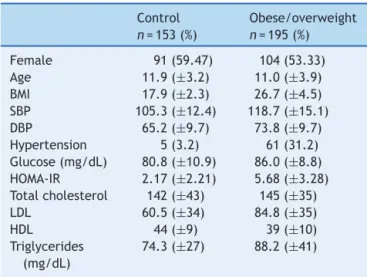www.jped.com.br
ORIGINAL
ARTICLE
Lack
of
association
between
genetic
polymorphism
of
FTO
,
AKT1
and
AKTIP
in
childhood
overweight
and
obesity
夽
Patrícia
de
Araújo
Pereira
a,1,
António
Marcos
Alvim-Soares
Jr.
a,∗,1,
Valéria
Cristina
Sandrim
d,
Carla
Márcia
Moreira
Lanna
c,
Débora
Cristine
Souza-Costa
b,
Vanessa
de
Almeida
Belo
b,
Jonas
Jardim
de
Paula
a,
José
Eduardo
Tanus-Santos
b,
Marco
Aurélio
Romano-Silva
a,
Débora
Marques
de
Miranda
aaUniversidadeFederaldeMinasGerais(UFMG),INCTdeMedicinaMolecular,BeloHorizonte,MG,Brazil
bUniversidadedeSãoPaulo(USP),FaculdadedeMedicinadeRibeirãoPreto(FMRP),DepartamentodeFarmacologia,
RibeirãoPreto,SP,Brazil
cUniversidadeFederaldeJuizdeFora(UFJF),InstitutodeCiênciasBiológicas,DepartamentodeFisiologia,JuizdeFora,
MG,Brazil
dUniversidadeEstadualPaulista(UNESP),SãoPaulo,SP,Brazil
Received15July2015;accepted15December2015 Availableonline21June2016
KEYWORDS
Single-nucleotide polymorphisms; Childhoodobesity; Fatmassandobesity associated;
Gene; AKT1; AKTIP
Abstract
Objective: Obesity isa chronicdisease caused by both environmental andgenetic factors. Epidemiologicalstudieshavedocumentedthatincreasedenergyintakeandsedentarylifestyle, aswellasageneticcontribution,areforcesbehindtheobesityepidemic.Knowledgeaboutthe interactionbetweengeneticandenvironmentalcomponentscanfacilitatethechoiceofthe mosteffectiveandspecificmeasuresforthepreventionofobesity.Theaimofthisstudywas toassesstheassociationbetweentheFTO,AKT1,andAKTIPgenesandchildhoodobesityand insulinresistance.
Methods: Thiswasacase---controlstudyinwhichSNPsintheFTO(rs99396096),AKT1,andAKTIP genesweregenotypedingroupsofcontrolsandobese/overweightchildren.Thestudyincluded 195obese/overweightchildrenand153controlsubjects.
Results: Asexpected,theobese/overweightgroupsubjectshadhigherbodymassindex,higher fasting glucose,HOMA-IRindex,totalcholesterol,low-densitylipoprotein,andtriglycerides. However,nosignificantdifferenceswereobservedingenespolymorphismsgenotypeorallele frequencies.
夽
Pleasecitethisarticleas:PereiraPA,Alvim-SoaresAM,SandrimVC,LannaCM,Souza-CostaDC,BeloVA,etal.Lackofassociation betweengeneticpolymorphismofFTO,AKT1andAKTIPinchildhoodoverweightandobesity.JPediatr(RioJ).2016;92:521---7.
∗Correspondingauthor.
E-mail:antonioalvimjr@gmail.com(A.M.Alvim-SoaresJr.). 1 BothAuthorscontributedequallytothispaper.
http://dx.doi.org/10.1016/j.jped.2015.12.007
Conclusion: ThepresentresultssuggestthatAKT1,FTO,andAKTIPpolymorphismswerenot associated withobesity/overweightinBrazilianschildren.Future studiesonthegeneticsof obesityinBrazilianchildrenandtheirenvironmentinteractionsareneeded.
©2016SociedadeBrasileiradePediatria.PublishedbyElsevierEditoraLtda.Thisisanopen accessarticleundertheCCBY-NC-NDlicense(http://creativecommons.org/licenses/by-nc-nd/ 4.0/).
PALAVRAS-CHAVE
Polimorfismosde nucleotídeoúnico; Obesidadeinfantil; Massadegordura obesidadeassociadas; Gene;
AKT1; AKTIP
Faltadeassociac¸ãoentreopolimorfismogenéticodoFTO,AKT1eAKTIPeo
sobrepesoeaobesidadeinfantis
Resumo
Objetivo: Aobesidadeéumadoenc¸acrônicasustentadaporfatoresambientaisegenéticos. Estudos epidemiológicos documentaram quemaioringestão deenergia e um estilo devida sedentário,bemcomoacontribuic¸ãogenética,sãoforc¸asportrásdaepidemiadeobesidade. Oconhecimentosobreainterac¸ãoentreoscomponentesgenéticoseambientaispodefacilitar aescolhadasmedidasmaisefetivaseespecíficasparaaprevenc¸ãodaobesidade.Oobjetivo desteestudofoiavaliararelac¸ãoentreosgenesFTO,AKT1eAKTIPeaobesidadeinfantile resistênciaàinsulina.
Métodos: Estudodecaso-controlenoqualSNPsnosgenesFTO(rs99396096),AKT1eAKTIPforam genotipadosemgruposdecontroleedecrianc¸asobesas/acimadopeso.Foramrecrutadas195 crianc¸asobesas/acimadopesoe153indivíduoscontrole.
Resultados: Comoesperado,osindivíduosdogrupoobeso/acimadopesoapresentarammaior índicedemassacorporal,maiorglicemiadejejum,índicedeHOMA-IR,colesteroltotal, lipopro-teínadebaixadensidadeetriglicerídeos.Contudo,nãoencontramosdiferenc¸assignificativas nogenótipodepolimorfismosgênicosounasfrequênciasalélicas.
Conclusão: NossosresultadossugeremqueospolimorfismosAKT1,FTOeAKTIPnãoestavam associadosàobesidade/sobrepesoemcrianc¸asbrasileiras.Sãonecessáriosestudosfuturossobre agenéticadaobesidadeemcrianc¸asbrasileirasesuasinterac¸õesambientais.
©2016SociedadeBrasileiradePediatria.PublicadoporElsevierEditoraLtda.Este ´eumartigo OpenAccesssobumalicenc¸aCCBY-NC-ND(http://creativecommons.org/licenses/by-nc-nd/4. 0/).
Introduction
Childhood obesity is a public health problem worldwide. Over the past decades, rates of overweight and obesity amongchildren have largely increasedboth in developed anddeveloping countries.1 Obesity is a resultof
environ-mental factors interacting with a polygenic background; the heritability ranges from40% to 70%.2 A recent
meta-regression analysis showedthat heritability washigher in children than in adults.3 Long-term studies have shown
that childhood obesity leads to clustering of metabolic syndrome (MetS) components,4 which include abdominal
obesity,dyslipidemia, insulin resistance, type II diabetes, and hypertension.5 It is well known that overweight and
obese children have a higher risk to become obese in adulthood.6
Genome-wideassociation studies (GWAS)identifiedthe Fat massand obesity associatedgene (FTO)asassociated withhumanadiposity.7 TheFTOgeneis relatedtoobesity
risk, especially the single nucleotide polymorphism (SNP) rs9939609, which has been further confirmed by others independent studies in different human populations.8---11
Duetothecloserelationshipbetweendiabetesandobesity, anotherinterestinggeneistheV-Aktmurinethymomaviral oncogenehomolog 1(AKT1), whichis thought tomediate
many metabolic, mitogenic, and anti-apoptotic effects of insulin, IGF-1, and IL-3, and other growth factors and cytokines.12---14Moreover,Aktalsostimulatesglucoseuptake
and glycogen synthesis,14 as well as protein synthesis.15
Severalstudiescorrelateinsulinresistancetoimpairments atAktpathwayand,incertainconditions,thesealterations can be of genetic origin. AKT1-binding protein (AKTIP or Ft1), located near to FTO at the same GWAS risk locus for obesity at chromosome 16 (16q12.2),16 appears to be
another targetfor investigation. AKTIP,asa direct-ligand ofAKT,modulatesintegrationsignalingpathways.17
Energy balance is influenced by a number of varia-bles such as diet, social structures, metabolic factors, modern sedentary lifestyle, inexpensive energy-dense foods, and genetics. Probably, common obesity is the result of an adverse obesogenic environment and a sus-ceptible genotype.4 To date, evidence for the possible
clinical benefits of genetic studies for common complex diseases has been limited. Furthermore, the search for geneticfactorsinvolvedinobesity isachallenge,andcan provide extra data to answer such a complex question. Throughtheseobservations,thisstudyaimedtoinvestigate the statistical association of polymorphisms in the FTO,
Methods
Clinicaldata
Parentsand children were informedand signed a written consentaboutthenatureandpurposeofthisstudy.All chil-dren were submittedtoa thoroughphysical examination. Height was measured using a wall-mounted stadiometer while bodyweight was measured through a digital scale. Body mass index (BMI) was calculated using weight and heightmeasurementsaccordingtotheequationBMI=weight (kg)/height2 (cm). The BMI cut-off points adopted were
thoseestablishedbytheWorldHealthOrganization(WHO).18
Overweightand obesity weredefined asBMI greater than +1and+2standarddeviation,respectively.19Bloodpressure
wasmeasuredatleasttwiceandthepresenceof hyperten-sionwasdefinedassystolicand/ordiastolicbloodpressure abovethe95thpercentile.20Noneofthechildrenused
med-ication.
Lipid profile and glycemia were determined in serum andplasma,respectively,withroutineenzymatic commer-cial kits (Labtest Diagnóstica, S.A., Brazil). Insulin levels weremeasuredusingakit(GenesisDiagnosticsProducts,São Paulo,Brazil).Insulinresistancewascalculatedby homeo-stasis model assessment asan index of insulin resistance (HOMA-IR), asdescribed by Wallace et al.21 To date, few
studieshavedefinedcut-offlevelsforHOMA-IRin prepuber-tal and pubertal individuals. Basedon that,HOMA-IR was testedascontinuousvariableandwascontrolledbytheBMI statusoftheindividuals.
Thelocalethicscommitteeapprovedthisstudyunderthe protocolCAAENo.06400000180-7.
Overweightandobesepatients
Thepresentsampleincluded195obese/overweightsubjects withmeanageof11.0(±3.9;104females),withBMI26.7 (±4.5). All subjects were recruited from the Endocrinol-ogyAmbulatory of the Adolescentand ChildInstitute and fromtheChildhoodEndocrinologyAmbulatoryoftheIMEPEN Foundation in Juiz de Fora, Brazil, and lived in urban areas.22,23
Controlgroup
Individuals in the control group were carefully selected fromthelocalcommunityandconsistedof 153eutrophic, normotensive individuals with mean age of 11.9 (±3.2; 91 females), and BMI 17.9 (±2.3). All subjects signed an informedconsentformandtheResearchEthicsCommittee oftheUniversityapprovedtheprotocols.
Genotyping
Genomic DNA was isolated using the high salt method after peripheral blood collection in vacuum tubes.24 The
selected probes corresponded tothe following SNPs: FTO
---rs9939609;AKTIP---rs9302648andrs7189819;andAKT1 ---rs2494738,rs3730358,andrs10149779.Toimprove statisti-calpower,onlySNPswithminorallelefrequencies>0.2in
CaucasianandYoruba individualsin the HapMap database were chosen. Genotyping was done with real-time poly-merasechainreaction(RT-PCR)usinga7500Real-TimePCR System(AppliedBiosystemsInc.,CA,USA),inallelic discrim-inationmode.PCRprotocolswereperformedinaccordance with the TaqMan® Genotyping Master Mix manufacturer’s
instructions(AppliedBiosystems,CA,USA).
Statisticalanalysis
Allele, haplotype and genotype frequencies were com-pared between groups with the chi-squared test using theUNPHASED software(UNPHASED, v.3.0.13,Cambridge, UnitedKingdom).251,000permutationstest(post-test)was
performed for each test in order to estimate the global significanceforallanalysesandtovalidatethe expectation-maximizationvalues.HAPLOVIEW4.1software(HAPLOVIEW, v4.1,BroadInstitute,MA,USA)wasusedtoevaluate pair-wiselinkagedisequilibrium(LD)matricesbetweeneachSNP to examine the LD block structure and Hardy---Weinberg equilibrium (cutoff 0.05).26 Odds ratio and permutations
wereperformedusingUNPHASED.AfterBonferroni correc-tion,the significance level wasestablished at 0.0083 for thegenotypevs.groupcomparisons.Clinicalcharacteristics oftheobese/overweightgroup werecomparedwiththose ofcontrolgroupbyone-wayanalysisofvariance(ANOVA), followed by Tukey’s post hoc test. Aiming to verify the detectionofgene---geneinteractionsassociatedwith com-plexhuman disease, multifactor dimensionalityreduction (MDR) and Multifactor Dimensionality Reduction Pedigree DisequilibriumTest(MDR-PDT)wereused.27
Atleast10%ofthesampleswerere-genotypedrandomly forquality control,thus minimizing genotyping errors.An agreementof100% between theresults ofboth tests was achieved.
A secondary analysis tested if the SNPs included in the present study were linearly associated with HOMA-IR and BMI. A linear regression model was used to test theassociation of each independent predictor(SNP) with eachmetabolicoutcome(HOMA-IRorBMI).Multiplelinear regressionswereused ifmore thanone predictorshowed associationwitheachoutcome.
Results
Atotalof sixSNPs weregenotypedin atotal of348 indi-viduals.All SNPswereinHardy---Weinberg equilibriumand showedaminorallelefrequency(MAF)higherthan10%, indi-catingagoodpenetrationoftheallelesinthepopulation.
Theclinicalandlaboratorialcharacteristicsofthe stud-ied groups are presented in Table 1. As expected, the subjects in the obese/overweight group had higher BMI. Incontrast tocontrol group, theobese/overweight group showedhigherfastingglucose,HOMA-IRindex,total choles-terol,low-density lipoprotein, andtriglycerides (p≤0.01;
Table1).
Table1 Demographiccharacteristicsofstudyparticipants.
Control n=153(%)
Obese/overweight n=195(%)
Female 91(59.47) 104(53.33)
Age 11.9(±3.2) 11.0(±3.9)
BMI 17.9(±2.3) 26.7(±4.5)
SBP 105.3(±12.4) 118.7(±15.1)
DBP 65.2(±9.7) 73.8(±9.7)
Hypertension 5(3.2) 61(31.2) Glucose(mg/dL) 80.8(±10.9) 86.0(±8.8) HOMA-IR 2.17(±2.21) 5.68(±3.28) Totalcholesterol 142(±43) 145(±35)
LDL 60.5(±34) 84.8(±35)
HDL 44(±9) 39(±10)
Triglycerides (mg/dL)
74.3(±27) 88.2(±41)
BMI, body mass index (kg/m2); SBP, systolic blood pressure
(mmHg); DBP, diastolic blood pressure (mmHg); HOMA-IR, HomeostasisModelAssessment---InsulinResistance;LDL, low-density lipoprotein (mg/dL); HDL, high-density lipoprotein (mg/dL).
Valuesarepresentedasmean±SD.
Genderandhypertensionaresamplesnumbers(%).
samepolymorphism alsoshowed nogenotypic association G/G(p=0.09;OR=0.61;2=6.29;df=2)incomparisonwith
eutrophicsubjects.ThegenotypeT/Tformarkerrs9302648 AKTIP also did not show association (p=0.09; OR=1.03;
2=7.15;df=2),after1000permutations test(post test).
Forothermarkers,noassociationswereobserved(Table2). Intheanalysisoftheinteractionbetweengenesthrough the multifactor dimensionality reduction, the dendogram indicated a relationship between the pairs of genes. The termsynergydenotesasituationinwhichtheinteraction, basedon the entropybetween twoSNPs, promotes more informationthanthecorrelationbetweenthepair.Inturn, redundancyisusedinthosecasesinwhichtheinteraction amidtwoSNPspromoteslessinformationthanthe correla-tionbetweenthepairs(Fig.1).
No association was observed in the analysis of insulin resistanceandthosepolymorphisms(datanotshown).
Although a significant p-value for genetic analysis of FTO rs9939609 was not obtained at the gene---gene
AKTIPrs9302648
FT0rs9939609
AKT1rs10149779
Redundance Synergism
Figure 1 Dendrogram of gene---gene interaction of obese patients and controls. The colors of the caption comprise a spectrum representing the transition of synergism (black) for redundancy (gray). Observe the following interactions: synergismbetween rs9939609 FTO andrs10149779 AKT1 and redundancybetweenthoseandrs9302648AKTIP.
analysis, an interaction between this one and AKT1 rs10149779wasfound.
Table3showstheresultfromlinearregressionmodels ---nosignificantassociationwasobservedbetweeneachSNPs andHOMA-RIorBMI.
Discussion
Obesityisanintricateclinicalconditionmodulatedbymany geneticandnon-genetic factors, withseveral interactions among many of them. A total of six non-coding SNPs of AKT1, AKTIP, and FTO genes were investigated as candi-date’s genes for obesity in Brazilian children. Our results suggest that the AKT1, FTO, and AKTIP polymorphisms were not associated with obesity/overweight in Brazilian children.Thefactthattheobese/overweightchildren car-rying the A alleleof the FTO rs9939609 did not show an increasedriskofbecomingobeseinthispopulationis note-worthy. This polymorphism has been associated with BMI and typeII diabetes in diverse populations,such asFinns andAsians.28---30Recently,GWASinCaucasians31andChinese
children32 identified multiple single nucleotide
polymor-phisms(SNPs),includingtheFTO gene,asassociatedwith BMIandobesity.AlthoughseveralvariantsoftheFTOgene havebeenassociatedtoobesityinpopulationsofEuropean background,itseffectsinotherethnicpopulationsremains tobeestablished.Inastudyinvolving478African-American children,noassociationbetweenvariantsoftheFTOgene and BMI wasfound, a resultsimilar toother studies with African-AmericanandGambianpopulations.33TheBrazilian
ethnicalblendingmightbeonereasonforthelackof asso-ciationwithaclassicalobesity-associatedpolymorphism.
FewstudiesregardingFTOvariantsandBMIinLatin Amer-icanchildrenandadolescentshavebeenpublishedtodate. DaSilvaetal.34 reportedasignificantassociationbetween
the A/A genotype of the FTO rs9939609 and increased BMIandsubcutaneousfatin348Brazilianchildren.35
Curi-ously,inanotherstudyregardingBrazilianchildren,theFTO
rs9939609 A allele was associated with an increased BMI between vitamin D insufficient children, whereas no sig-nificant effect was observed among those with adequate vitaminDstatus.This mightbeatypeIerror,butitmight alsomeanthatthisproblemismorecomplexthanexpected, involvinganothermetabolicfactors.
Todate,fewstudieshaveassociatedvariantsintheAKT1
gene and insulin resistance. In a recent study, a haplo-type including the first exon of the AKT1 was associated withahigherfrequencyofmetabolicsyndromein African-AmericanandEuropean-Americansubjects.36
Inthepresent study,at thegene---geneanalysis(MDR), aninteractionbetweenFTOrs9939609andAKT1rs10149779 wasfound.Onepossiblereasonforthisdifferencebetween singlepolymorphism andMDRanalysis resultsmaybe due to epistasis, defined as the interaction between two or more genes or their mRNAprotein products modulatinga phenotype.37 Statistical analyzes and animal modelshave
Table2 GenotypeandallelefrequenciesofthesixtagSNPsofFTO/AKT1/AKTIPpolymorphismsinthesample.
Obesity/overweight n=195(%)
Control n=153(%)
OR 95%Lo
95%Hi
2 df p-value
(1000permut.)
AKT1 rs2494738
G/G 150(76.92) 126(82.25) 1(ref) 1.13 2 0.56
A/G 30(15.38) 18(11.76) 1.40 0.73---2.63
A/A 01(0.5) 1(0.65) 0.84 0.05---13.57
Ga 330(84.62) 270(88.24) 1(ref) 0.83 1 0.36
A 32(8.2) 20(6.54) 1.30 0.73---2.34
rs3730358
G/G 116(59.49) 90(58.82) 1(ref) 2.31 2 0.31
A/G 54(27.69) 48(31.37) 0.87 0.54---1.40
A/A 11(5.64) 4(2.61) 2.13 0.65---6.23
Ga 286(73.33) 228(74.51) 1(ref) 0.15 1 0.68
A 76(19.49) 56(18.3) 1.08 0.73---1.59
rs10149779
G/G 94(48.21) 55(35.95) 1(ref) 6.29 2 0.04(0.09)
G/A 73(37.44) 76(49.68) 0.56 0.35---0.89
A/A 18(9.23) 17(11.11) 0.61 0.29---1.30
Ga 261(37.83) 186(60.78) 1(ref) 4.40 1 0.03(0.20)
A 109(27.95) 110(35.95) 0.70 0.51---0.97
AKTIP
rs9302648
T/T 76(38.97) 46(30.07) 1(ref) 7.15 2 0.02(0.09)
G/T 76(38.97) 82(53.59) 0.56 0.34---0.90
G/G 36(18.46) 21(13.73) 1.03 0.54---1.98
Ta 228(58.46) 174(56.86) 1(ref) 0.34 1 0.55
G 148(37.95) 124(40.52) 0.91 0.66---1.24
rs7189819
C/C 67(34.36) 61(39.87) 1(ref) 0.95 2 0.61
C/T 84(43.08) 65(42.48) 1.17 0.73---1.89
T/T 34(17.44) 23(15.03) 1.34 0.71---2.53
Ca 218(55.9) 187(61.11) 1(ref) 1.01 1 0.31
T 152(38.97) 111(36.27) 1.17 0.85---1.60
FTO
rs9939609 rs9939609
A/A 44(22.56) 34(22.22) 1(ref) 4.42 2 0.10
T/A 45(23.08) 71(46.41) 1.14 0.66---1.96
T/T 39(20.0) 46(30.07) 0.65 0.35---1.21
Aa 193(49.49) 139(45.42) 1(ref) 1.88 1 0.16
T 183(46.92) 163(53.27) 0.80 0.59---1.09
Adjustedp-valuefrompermutationtest:0.2(allele);adjustedp-valuefrompermutationtest:0.09(genotypic);df,degreeoffreedom, df=1betweentwoalleles;df=2betweenthreegenotypes;asignificantassociationisindicatedinboldanditalic(<0.05);adjusted p-valuefrom1000permutationtest(multipletesting---Unphased).
OR,oddsratio.
a Ancestralallele.
As some studies indicated that FTO had larger effects onchildhoodBMIathigherpercentiles,39alinearregression
was performed; however, no such association was found. Somenegativeassociation findingsmight resultfromsome limitationsofthestudy,mainlythesmallsamplesize. More-over,thestudydidnotconsiderenvironmentalfactors,such asthepatternsof physical activity,thepresence of over-weight/obeseparents,andthedataconcerningfoodintake, whichpreventsfurtheranalysis.
Table3 LinearregressionmodeladdressingthecontributionsofeachSNPtoHOMA-IRandBMIinthepresentsample.
LinearregressionmodelsforHOMA
Predictor F p adjR2 Std.beta t
AKT1rs2191738HEX/FAMA/G 0.00 0.983 0.00 0.01 0.22
AKT1rs3730358HEX/FAMA/G 0.12 0.725 0.00 0.02 0.35
AKT1rs10119779HEX/FAMA/G 0.02 0.880 0.00 0.01 0.15
FTOrs9939309HEX/FAMA/T 0.00 0.971 0.00 0.00 0.03
AKTIPrs9302318HEX/FAMG/T 0.65 0.421 0.00 0.05 0.81
AKTIPrs7189819HEX/FAMC/T 0.33 0.567 0.00 0.04 0.57
LinearregressionmodelsforBMI
Predictor F p adjR2 Std.beta t
AKT1rs2191738HEX/FAMA/G 0.01 0.919 0.00 0.00 0.10
AKT1rs3730358HEX/FAMA/G 0.06 0.802 0.00 −0.01 −0.25
AKT1rs10119779HEX/FAMA/G 2.23 0.137 0.00 −0.08 −1.49
FTOrs9939309HEX/FAMA/T 3.08 0.080 0.01 −0.09 1.75
AKTIPrs9302318HEX/FAMG/T 0.05 0.816 0.00 0.01 0.23
AKTIPrs7189819HEX/FAMC/T 1.38 0.240 0.00 −0.06 −1.18
HOMA,homeostasismodelassessmentindex;BMI,bodymassindex;adjR2,adjustedR2;std.beta,standardizedregressioncoefficient.
Insummary, noevidenceofassociation betweenAKT1, AKTIP and FTO polymorphisms with obesity and insulin resistance was observed in this sample of Brazilian chil-dren.Thereareseveralreasonsforthecontrastingresults observed within the studies, including differences in the genetic background of the different samples. Consider-ing the associations found in other studies, the authors believethatstudiesinvolvingalargernumberofindividuals withdifferentethnicgroups mayberequiredtoelucidate the role of these genes with obesity. Thus, the present study emphasizes the importance of caution when ana-lyzingcandidate-gene studies andreinforcesthe need for well-conductedstudiestoexpandtheunderstandingofthe geneticandenvironmental factorsinvolvedin obesityand insulinresistance.
Funding
CAPES, FAPESP, CNPq (FAPEMIG: CBB-APQ-00075-09/CNPq 573646/2008-2),andFAPEMIG:CDS-BPD-00296-14.
Conflicts
of
interest
Theauthorsdeclarenoconflictsofinterest.
Acknowledgements
ThisstudywassupportedbyCAPES,FAPESP,CNPq(FAPEMIG: CBB-APQ-00075-09/CNPq 573646/2008-2), and FAPEMIG: CDS-BPD-00296-14.
References
1.DaneseA,TanM.Childhoodmaltreatmentandobesity: system-aticreviewandmeta-analysis.MolPsychiatry.2014;19:544---54.
2.HerreraBM,KeildsonS,LindgrenCM.Geneticsandepigenetics ofobesity.Maturitas.2011;69:41---9.
3.ElksCE,denHoedM,ZhaoJH,SharpSJ,WarehamNJ,LoosRJ, etal.Variabilityintheheritabilityofbodymassindex:a system-aticreviewandmeta-regression.FrontEndocrinol(Lausanne). 2012;3:29.
4.SarrafzadeganN,Gharipour M,SadeghiM,NouriF,AsgaryS, ZarfeshaniS.Differencesintheprevalenceofmetabolic syn-drome in boys and girls based on various definitions. ARYA Atheroscler.2013;9:70---6.
5.Cornier MA, Dabelea D, Hernandez TL, Lindstrom RC, Steig AJ, Stob NR, et al. The metabolic syndrome. Endocr Rev. 2008;29:777---822.
6.FieldAE,CookNR,GillmanMW.Weightstatusinchildhoodas apredictorof becomingoverweightor hypertensiveinearly adulthood.ObesRes.2005;13:163---9.
7.StratigopoulosG, PadillaSL,LeDucCA,WatsonE,Hattersley AT,McCarthyMI,etal.RegulationofFto/Ftmgeneexpression inmiceandhumans.AmJPhysiolRegulIntegrCompPhysiol. 2008;294:R1185---96.
8.SpeliotesEK,WillerCJ,BerndtSI,MondaKL,ThorleifssonG, JacksonAU,etal.Associationanalysesof249,796individuals reveal18newlociassociatedwithbodymassindex.NatGenet. 2010;42:937---48.
9.ScuteriA,SannaS,ChenWM,UdaM,AlbaiG,StraitJ,etal. Genome-wideassociationscanshowsgeneticvariantsintheFTO geneare associatedwithobesity-relatedtraits. PLoSGenet. 2007;3:e115.
10.PeetersA, Beckers S,Verrijken A, RoevensP,Peeters P,Van Gaal L, et al. Variantsin the FTOgeneare associatedwith commonobesityintheBelgianpopulation.MolGenetMetab. 2008;93:481---4.
11.Villalobos-Comparán M, Teresa Flores-Dorantes M, Teresa Villarreal-Molina M, Rodríguez-Cruz M, García-Ulloa AC, Robles L, et al. The FTOgene is associated withadulthood obesity in the Mexican population. Obesity (Silver Spring). 2008;16:2296---301.
12.FrankeTF, KaplanDR,CantleyLC.PI3K: downstreamAKTion blocksapoptosis.Cell.1997;88:435---7.
14.ManningBD,CantleyLC.AKT/PKBsignaling:navigating down-stream.Cell.2007;129:1261---74.
15.LescheR, PeetzA,vanderHoevenF,RütherU. Ft1a novel generelatedtoubiquitin-conjugatingenzymes,isdeletedinthe Fusedtoesmousemutation.MammGenome.1997;8:879---83. 16.Davies RW,Lau P, Naing T, Nikpay M, Doelle H, HarperME,
etal.A680kbduplicationattheFTOlocusinakindredwith obesityandadistinctbodyfatdistribution.EurJHumGenet. 2013;21:1417---22.
17.RemyI,MichnickSW.RegulationofapoptosisbytheFt1 pro-tein,anewmodulatorofproteinkinaseB/Akt.MolCellBiol. 2004;24:1493---504.
18.JointWHO/FAOExpertConsultationonDiet,Nutritionandthe Prevention ofChronicDiseases (2002:Geneva, Switzerland). Diet,nutritionandthepreventionofchronicdiseases:report ofajointWHO/FAOexpertconsultation,Geneva,28January---1 February2002.
19.Kuczmarski RJ, Ogden CL, Grummer-Strawn LM, Flegal KM, GuoSS,WeiR,et al.CDCgrowthcharts:UnitedStates.Adv Data.2000;(314):1---27.
20.Updateon the 1987 TaskForce Report on High Blood Pres-sureinChildrenandAdolescents:aworkinggroupreportfrom theNationalHighBloodPressureEducationProgram.National High Blood Pressure Education Program Working Group on HypertensionControlinChildrenandAdolescents.Pediatrics. 1996;98:649---58.
21.WallaceTM,Levy JC, MatthewsDR.Useand abuseofHOMA modeling.DiabetesCare.2004;27:1487---95.
22.Souza-CostaDC,BeloVA,SilvaPS,SertorioJT,MetzgerIF,Lanna CM,etal.eNOShaplotypeassociatedwithhypertensioninobese childrenandadolescents.IntJObes(Lond).2011;35:387---92. 23.de Miranda JA, Lacchini R, Belo VA, LannaCM, Sertorio JT,
LuizonMR,etal.Theeffectsofendothelialnitricoxidesynthase tagSNPsonnitritelevelsandriskofhypertensionandobesityin childrenandadolescents.JHumHypertens.2015;29:109---14. 24.Lahiri DK, Nurnberger JI Jr. A rapid non-enzymatic method
forthepreparationofHMWDNAfrombloodforRFLPstudies. NucleicAcidsRes.1991;19:5444.
25.DudbridgeF.Likelihood-basedassociationanalysisfornuclear familiesand unrelated subjects withmissinggenotype data. HumHered.2008;66:87---98.
26.Barrett JC, Fry B, Maller J, Daly MJ. Haploview: analysis and visualizationof LD and haplotype maps. Bioinformatics. 2005;21:263---5.
27.MotsingerAA,RitchieMD.Multifactordimensionalityreduction: ananalysis strategy for modelling and detecting gene---gene
interactionsinhumangeneticsandpharmacogenomicsstudies. HumGenomics.2006;2:318---28.
28.CecilJE, TavendaleR, Watt P,HetheringtonMM, PalmerCN. Anobesity-associatedFTOgenevariantandincreasedenergy intakeinchildren.NEnglJMed.2008;359:2558---66.
29.Scott LJ, Mohlke KL, Bonnycastle LL, Willer CJ, Li Y, Duren WL, et al. A genome-wide association study of type 2 dia-betesinFinnsdetectsmultiplesusceptibilityvariants.Science. 2007;316:1341---5.
30.WenW,ChoYS,ZhengW,DorajooR,KatoN,QiL,etal. Meta-analysisidentifiescommonvariantsassociatedwithbodymass indexineastAsians.NatGenet.2012;44:307---11.
31.Meyre D, Delplanque J, Chèvre JC, Lecoeur C, Lobbens S, GallinaS,etal.Genome-wideassociationstudyforearly-onset andmorbidadultobesityidentifiesthreenewrisklociin Euro-peanpopulations.NatGenet.2009;41:157---9.
32.WuL,XiB,ZhangM,ShenY,ZhaoX,ChengH,etal. Associa-tionsofsixsinglenucleotidepolymorphismsinobesity-related geneswithBMIandriskofobesityinChinesechildren.Diabetes. 2010;59:3085---9.
33.GrantSF,LiM,BradfieldJP,KimCE,AnnaiahK,SantaE,etal. AssociationanalysisoftheFTOgenewithobesityinchildrenof CaucasianandAfricanancestryrevealsacommontaggingSNP. PLoSONE.2008;3:e1746.
34.daSilvaCF,ZandonáMR,VitoloMR,CampagnoloPD,RottaLN, AlmeidaS,etal.Associationbetweenafrequentvariantofthe FTOgeneandanthropometricphenotypesinBrazilianchildren. BMCMedGenet.2013;14:34.
35.Lourenc¸oBH,QiL,WillettWC,CardosoMA.ACTIONStudyTeam. FTOgenotype,vitaminDstatus,andweightgainduring child-hood.Diabetes.2014;63:808---14.
36.Devaney JM,Gordish-Dressman H,Harmon BT, BradburyMK, Devaney SA, Harris TB, et al. AKT1 polymorphisms are associated with risk for metabolic syndrome. Hum Genet. 2011;129:129---39.
37.CarlborgO,HaleyCS.Epistasis:toooftenneglectedincomplex traitstudies?NatRevGenet.2004;5:618---25.
38.WardenCH,YiN,FislerJ.Epistasisamonggenesisauniversal phenomenoninobesity:evidencefrom rodentmodels. Nutri-tion.2004;20:74---7.
39.Mitchell JA, Hakonarson H, Rebbeck TR, Grant SF. Obesity-susceptibilitylociandthetailsofthepediatricBMIdistribution. Obesity(SilverSpring).2013;21:1256---60.


